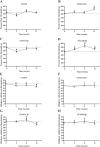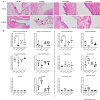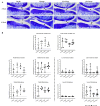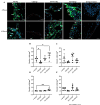Targeting STAT6-mediated synovial macrophage activation improves pain in experimental knee osteoarthritis
- PMID: 38509602
- PMCID: PMC10953260
- DOI: 10.1186/s13075-024-03309-6
Targeting STAT6-mediated synovial macrophage activation improves pain in experimental knee osteoarthritis
Abstract
Background: Pain from osteoarthritis (OA) is one of the top causes of disability worldwide, but effective treatment is lacking. Nociceptive factors are released by activated synovial macrophages in OA, but depletion of synovial macrophages paradoxically worsens inflammation and tissue damage in previous studies. Rather than depleting macrophages, we hypothesized that inhibiting macrophage activation may improve pain without increasing tissue damage. We aimed to identify key mechanisms mediating synovial macrophage activation and test the role of STAT signaling in macrophages on pain outcomes in experimental knee OA.
Methods: We induced experimental knee OA in rats via knee destabilization surgery, and performed RNA sequencing analysis on sorted synovial tissue macrophages to identify macrophage activation mechanisms. Liposomes laden with STAT1 or STAT6 inhibitors, vehicle (control), or clodronate (depletion control) were delivered selectively to synovial macrophages via serial intra-articular injections up to 12 weeks after OA induction. Treatment effects on knee and hindpaw mechanical pain sensitivity were measured during OA development, along with synovitis, cartilage damage, and synovial macrophage infiltration using histopathology and immunofluorescence. Lastly, crosstalk between drug-treated synovial tissue and articular chondrocytes was assessed in co-culture.
Results: The majority of pathways identified by transcriptomic analyses in OA synovial macrophages involve STAT signaling. As expected, macrophage depletion reduced pain, but increased synovial tissue fibrosis and vascularization. In contrast, STAT6 inhibition in macrophages led to marked, sustained improvements in mechanical pain sensitivity and synovial inflammation without worsening synovial or cartilage pathology. During co-culture, STAT6 inhibitor-treated synovial tissue had minimal effects on healthy chondrocyte gene expression, whereas STAT1 inhibitor-treated synovium induced changes in numerous cartilage turnover-related genes.
Conclusion: These results suggest that STAT signaling is a major mediator of synovial macrophage activation in experimental knee OA. STAT6 may be a key mechanism mediating the release of nociceptive factors from macrophages and the development of mechanical pain sensitivity. Whereas therapeutic depletion of macrophages paradoxically increases inflammation and fibrosis, blocking STAT6-mediated synovial macrophage activation may be a novel strategy for OA-pain management without accelerating tissue damage.
Keywords: Signal transducer and activator of transcription 6; macrophages; osteoarthritis; pain.
© 2024. The Author(s).
Conflict of interest statement
C.T. Appleton: consulting – AbbVie, Lily, Novartis, Pfizer.
Figures






References
-
- Schnitzer TJ, Ekman EF, Spierings EL, Greenberg HS, Smith MD, Brown MT, et al. Efficacy and safety of tanezumab monotherapy or combined with non-steroidal anti-inflammatory drugs in the treatment of knee or hip osteoarthritis pain. Ann Rheum Dis. 2015;74(6):1202–1211. doi: 10.1136/annrheumdis-2013-204905. - DOI - PubMed
MeSH terms
Substances
LinkOut - more resources
Full Text Sources
Molecular Biology Databases
Research Materials
Miscellaneous

